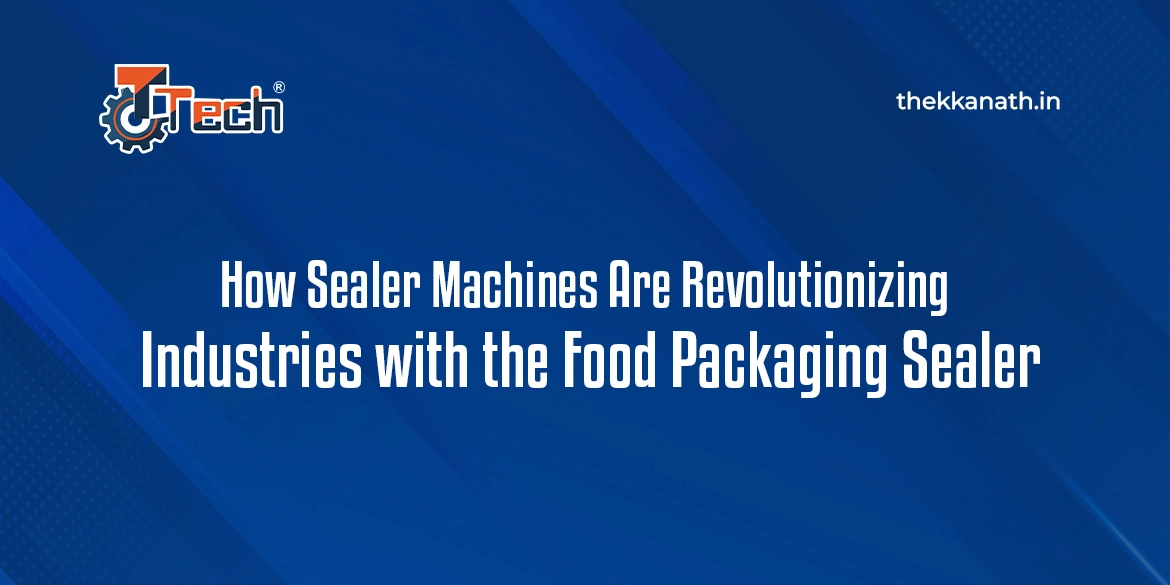
In the fast-paced, quality-oriented world of today, the need for seamless packaging has increased exponentially. One of the most revolutionary changes fueling this process is the Food Packaging Sealer. Right from keeping foods fresh to beautifying product presentation and providing security, sealer machines have become a necessity for various industries. This blog is an in-depth look at the kinds of sealer machines and how all of them are transforming workflows in industries such as food, pharmaceuticals, cosmetics, and others, with a focus on the central star: the Food Packaging Sealer.
Contents
What is a Food Packaging Sealer?
Food Packaging Sealer is equipment employed to seal bags, pouches, containers, or any other package to seal the product, avoid contamination, and provide shelf life. They come in various forms such as hand sealers, band sealers, vacuum sealers, induction sealers, and foil sealers. They are employed for various uses in packaging, starting from domestic use on a small level to production on an industrial level.
Hand Sealers: Minimum Effort, Maximum Effect
Hand sealers are most likely the first purchase for domestic kitchens, small businesses, or new businesses. They are cheap, easy to use, and perfect for sealing polyethylene or laminated packs. Take a home snack business, for example—having a Food Packaging Sealer, like a hand sealer gives a professional touch to each packet. It keeps it fresh and gives the product a market-fresh look. It helps in building a good brand impression.
Continuous Band Sealers: Speeding Up the Game
As production increases, it must be sealed. Continuous band sealers are best suited for high-volume operations, where efficiency and reliability are a top concern. They use a conveyor belt to force packages through a heat-sealing machine, so they are effective for medium to large enterprises.
With a Food Packaging Sealer like this, companies can seal dozens of pouches in an hour—snacks, frozen foods, powdered foods—all with accuracy and less labor by hand. That accuracy translates to more efficiency and less labor expense, putting your company ahead in today’s competitive market.
Shelf Life Extension Vacuum Sealing Machines
Vacuum sealers perform the procedure one step ahead by removing the air inside the package prior to sealing it. Oxygen is the biggest foe of food when preservation is at stake, and removing it stops spoilage, oxidation, and bacterial growth.
A Food Packaging Sealer, like a vacuum sealer, is particularly worth its weight in gold to the meat, fish, and dairy industries. They have a longer shelf life, are cleaner, and less food is wasted. And vacuum-sealed products are lighter to ship and store, making them a wonderful option for retail and export as well.
Safety Under the Cap Induction sealers are typically used by liquid packaging businesses—those filling oils, syrups, cosmetics, and pharmaceuticals, to name a few. Induction sealers create a seal by attaching foil liners to container rims through electromagnetic induction. The result? A leak-free, tamper-evident seal.
A Food Packaging Sealer, like an induction machine, is a critical component in the assurance of product integrity and customer trust. It also aids in regulatory compliance with strict measures of safety in regulated markets. In our current era, companies increasingly understand that a safe seal preserves the product from harm, but also builds brand image.
Foil Sealers: Cleanliness Meets Aesthetics
Foil sealer machines are needed for those items that need appearance and cleanliness. From health supplement jars and spice jars to specialty coffee jars, a foil sealer will keep the product from becoming contaminated until it is opened.
Incorporating a Food Packaging Sealer, like a foil seale,r allows organizations to incorporate quality control measures, especially when dealing with fragile or perishable items. It also adds another element of professional elegance to the package that discerning buyers in today’s market appreciate.
Why the Arrival of the Food Packaging Sealer is Business-Changing
Be it at a roadside kiosk retailing pickled food bites or a pharma multinational repacking liquid medicines in packs, the job of a Food Packaging Sealer cannot be exaggerated. Certain industry-specific impacts are elaborated below:
Less Waste: Tamper-evident and airtight packaging optimizes shelf life and reduces waste.
Brand Value: Properly sealed packaging adds value, so even thin lines appear upscale. Compliance & Hygiene: Helps in compliance with health and safety regulations, particularly in the food and pharma industries.
Operational Efficiency: New sealer machines eliminate the need to depend on labor, improving consistency and speed.
Prospects for Future Food Packaging Sealing Technology Trends
Packaging of the future is automation and sustainability. Future Food Packaging Sealer machines are already embracing smart sensors, IoT connectivity, and green sealing materials. All these aim at conserving energy, minimizing plastic usage, and enhancing real-time quality monitoring.
We will also see more hybrid machines—those which combine sealing with other functions like labelling, date coding, and inspection—to have a smooth packaging line with minimum human intervention.
Final Thoughts
At a time when there is high demand from customers, and operational effectiveness is most important, the appropriate Food Packaging Sealer investment may be the difference between the success and failure of a business. These are not machines—trust, expansion, and innovation enablers.
